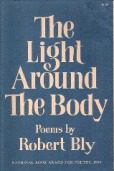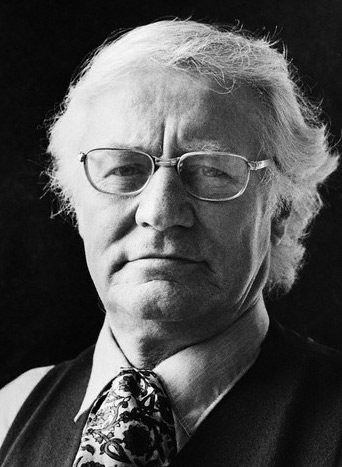The Light Around The Body
by Robert Bly
Harper & Row, 1967
 Robert Bly is a poet arguably best-known for his work in the men’s movement, for his translations of European and South American poets, and for his work redeveloping the ideas of Jerome Rothenberg and Robert Kelly in a retooled “Deep Image school” of poets alongside his friend James Wright.
Robert Bly is a poet arguably best-known for his work in the men’s movement, for his translations of European and South American poets, and for his work redeveloping the ideas of Jerome Rothenberg and Robert Kelly in a retooled “Deep Image school” of poets alongside his friend James Wright.
The Light Around The Body is Robert Bly’s second book and like his first collection Silence in the Snowy Fields it contains poems in the deep image style but it also introduces Bly’s war poetry, chiefly relating to American involvement in Vietnam, which he later went on to showcase more fully in poems like ““The Teeth Mother Naked at Last”“.
Indeed, the poems in The Light Around The Body, which won the 1968 National Book Award, are heavily political, socially conscious and left-leaning. Unsurprisingly, Bly contributed the NBA prize money to the anti-war effort. However, to locate these poems purely in their historical context is to ignore their prescience and relevance to our current political (and geo-political) climate. Look at some of the titles: “Listening to President Kennedy Lie about the Cuban Invasion”, “Asian Peace Offers Rejected without Publication”, “Those Being Eaten by America”, “The Current Administration”.
Bly’s poetics can seem opaque at times: He often leaves distances between consecutive images, requiring a mental or emotional jump from the reader, something he has referred to as “poetry that leaps”. It occasionally overleaps but when they are successful Bly’s images are often startling and portentous. This, from “Driving through Minnesota during the Hanoi Bombings” :
...Our own gaiety Will end up In Asia, and in your cup you will look down And see Black Starfighters. We were the ones we intended to bomb!
Most of the poems employ a portentous but intense, definitely masculine tone. Conversely, in one of the book’s major themes, Bly criticizes what he calls the outer world (masculine, practical) and calls for a redress of the balance by moving toward the inner world (feminine, imaginative):
...The two Romans had put their trust In the outer world. Irons glowed Like teeth. They wanted her To assure them. She refused. Finally they took burning Pine sticks, and pushed them Into her sides. Her breath rose And she died. The executioners Rolled her off onto the ground. A light snow began to fall And covered the mangled body, And the executives, astonished, withdrew. The other world is like a thorn In the ear of a tiny beast! The fingers of the executives are too thick To pull it out! It is like a jagged stone Flying toward them out of the darkness.
It is true that his work escapes at times, substituting alluring oddity for opacity but it is also true that this collection contains some of Bly’s most intuitive and powerful poems. One of the most famous poems in The Light Around The Body, “Counting Small-Boned Bodies”, makes good use of Bly’s intuitive impulses and knack for surprising imagery:
Let’s count the bodies over again.
If we could only make the bodies smaller,
The size of skulls…
…If we could only make the bodies smaller,
Maybe we could get
A whole year’s kill in front of us on a desk !
If we could only make the bodies smaller,
We could fit
A body into a finger-ring, for a keepsake forever.
Robert Bly is a unique poet who draws upon many influences, not least the Scandinavian and Spanish-language poets he has translated.
The poems in The Light Around The Body are humane, visionary and have a sense of permanent relevance, of an intense conscience and imagination at work, reaching out, feeling around in the darkness for something of great importance.
– Christopher Crawford
